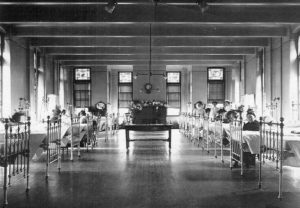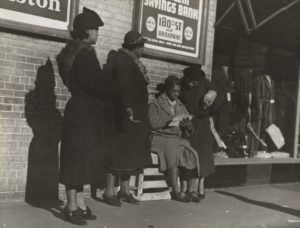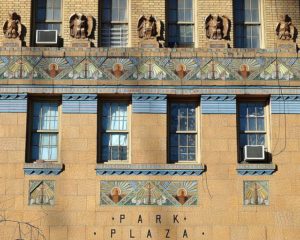HG’s late Mom, Ida Kopkind Freeman, fed growing HG cuisine ranging from the celestial to the abysmal. Celestial soups: In hot weather, there was icy beet borscht and “schav” (sorrel soup). Both served with a boiled potato, sour cream and chopped onions and radishes. In cold weather: Chicken soup with noodles or “kasha” (buckwheat groats) or fluffy matzo balls. Sometimes all three. “Kapusta” (robust Russian meat and cabbage soup). Mushroom and barley (little HG’s fave). Celestial appetizers: Chopped liver (heavy on lush chicken fat). Gefilte fish (with fiery fresh horseradish grated by HG). “Kreplach” (Jewish dumplings fried in chicken fat). Celestial main dishes: Brisket (“gehdempteh brust” in Yiddish). Sweet and sour stuffed cabbage. Celestial “dairy dishes”: Blintzes; broad egg noodles with pot cheese, kosher salt and cracked black peppercorns; potato “latkes” with sour cream (never apple sauce); matzo brei. Also, bananas or seasonal fruit with sour cream. Celestial baked treats: Noodle and potato kugels; rugelach; “Lekach” (honey cake). Abysmal: All vegetables and salads (a honey and ginger dish of shaved carrots cooked with garlic and chicken fat was known as “tzimmes” was the exception. It was served warm and was delicious.) Absymal: Kosher steak (gristly, tough and broiled beyond well done). Tasteless boiled chicken. Hamburgers fried in Crisco. Mueller’s spaghetti cooked into a sodden mess and covered in canned tomatoes. “American” fried chicken: boiled chicken covered with corn flakes and cooked, once more, in Crisco (this dish made abysmal move into horror). Abysmal desserts: Stewed prunes or canned pears. In retrospect, food winners outnumbered losers and HG thrived. Hey, there was the best after school snack ever. A slice of Pechter’s (or Stuhmer’s) pumpernickel smeared with chicken fat and sprinkled with kosher salt and black pepper (sometimes a slice of raw onion was added). (Patient HG fans: Yes, many posts about HG’s Mom. A pre-Mother’s Day tribute).
Mom’s Cuisine: The Highs and The Lows
May 6th, 2020 § 0 comments § permalink
HG’s Late Mom VS Vermin
May 5th, 2020 § 0 comments § permalink
HG’s Mom (Ida Kopkind Freeman) did not fear insects vermin. She would grab big, scary spiders with her hands and crush them. Same went for water bugs, hornets (even the “Murder Hornet” had they been around) and other creepy-crawlies, big and small. Hands were vigorously washed with strong “laundry” soap. Very busy woman: Cleaning. Washing. Dusting. Making beds and changing sheets. Cooking. Pickling. Canning. Knitting. Sewing. Crocheting. No idle moments. Mom grew up in a tiny Belorussian “shetl” Life was rugged. When Mom was seven years old, she went out into the summer warmth to tend the vegetable garden. A very large rat was nibbling a cucumber. Mom kicked the rat with her bare foot. Enraged, the nasty rodent sunk its teeth into Mom’s big toe. The bite cracked a bone. Mom strangled the rat because it wouldn’t let go. No doctors in the “shetl”. So, the bloody wound was treated with a salve made by a neighbor, an old woman named Pesha. Never healed properly. Left a big bump. Painful when walking or standing for a long time. Mom shrugged it off. Hey, worse things happened to Jews in Europe. In the late 1930’s, after family pressure, Mom finally went to a hospital for a toe operation. Loved being in the hospital for a few days. Total leisure. She could lie in a comfortable bed and listen to favorite soap operas on the radio as well as the Yiddish station, WEVD. That was Mom’s taste of luxury.
Yinglish
May 4th, 2020 § 0 comments § permalink
Yiddish was the language of Ashkenazi Jews. Scorned by Zionists who felt it echoed the European ghettoes, they replaced it with Modern Hebrew. However diminished (millions of Yiddish speakers were murdered in the Holocaust), Yiddish lingers on. There is a splendid body of literature (and much poetry) in Yiddish. I.B. Singer, Nobel prize winner, was one of many important writers whose work was in Yiddish. HG’s late Mom. was born Ida Kopkind in a Belorussian “shtetl” in the Minsk province. She spent the majority of her life in Bronx apartments before her death in a nursing home. Yiddish is a very flexible language, reflecting the nomadic life of Jews in the diaspora. Mom adapted Yiddish into a language HG calls “Yinglish.” How did Mom identify her apartment house neighbors? The woman next door was the “nextdoorehkeh.” And, so on: “upstezzehkeh”, “downstezzehkeh”, “groundfloorehkeh”. An unsavory person was a “nogoodnik.” A flighty young woman, possibly free with her favors, was a “bummerkeh.” Mom Yinglishized geography. HG’s family lived in “Duh Bronix”. Relatives lived in “Brunzevlle” (the Brownsville neighborhood of Brooklyn). A non sequitur: Mom was very gracious when it came to complimenting unmarried women. No matter how unsightly, Mom would always focus on a desirable feature. About a spinster with a face like a potato, Mom pointed out: “She has lovely hands.”
Reading
April 28th, 2020 § 2 comments § permalink
Reading has always been a solace for HG. Did not have the money to buy books growing up during the Great Depression but, armed with a library card, literary riches were available for HG (starting at age five) at the Highbridge and Bainbridge public libraries in The Bronx. During this period of isolation at HG/BSK’s New Mexico home, HG (as always) is finding pleasure in books. Yes, books. No Kindle. The old guy likes the feel of a book in his hands. And, an illustrated book adds to the pleasure. So, what has HG been reading? There were two gifts from gifted daughter, Lesley R., and husband, Profesore Massimo R. One was “The Europeans” by Orlando Figes, an illuminating analysis of the making of a cosmopolitan culture. (Figes books on Russia and the Russian revolution are essential reading.) The other gift was “The Seine: The River That Made Paris” by Elaine Sciolino (she also wrote a delightful book about Rue des Martyrs, HG’s favorite Parisian street). HG is a devotee of everything English so had a good time with Penelope Lively’s “A House Unlocked” (learned much about the English countryside during World War Two; was taught the difference between a walk and a ramble). John Le Carre’s “Agent Running In The Wild” was not up to the master’s scintillating standard. “Boulevard of Dreams: Heady Times, Heartbreak, and Hope Along The Grand Concourse In The Bronx’ by Constance Rosenblum, is pedestrian but brought back many memories from HG’s youth. While browsing the bookcase, HG discovered “Italian Holiday” by Ludwig Bemelmans. Haven’t read it in 37 years but it remains relevant and sprightly despite some dated and condescending remarks about homosexuals (illustrations are as charming as ever). Brendan Gill’s: “A New York Life: Of Friends and Others” is the best bedtime reading. His mini-profiles of New Yorkers and others are clear-eyed, graceful and devoid of sentimentality — the product of a steely intelligence, a searching eye and a satisfying prose style. Ben Katchor’s “The Dairy Restaurant” is a very eccentric book. The drawings by Katchor are magnificent. Page after page of prose tells the reader more than he or she might ever want to know about Jewish dietary laws and the tortuous history of New York’s (and Europe’s} Jewish dairy restaurants. Happily, the book ends with profiles (and reproductions of their vast menus) of HG’s favorite four dairy restaurants (all gone) Rappaport’s (Second Avenue); Ratner’s (Delancey Street); Steinberg’s (Broadway in the West 80’s); Famous (West 72nd Street). Made HG very hungry.
Happy Bronx Memories
April 24th, 2020 § 0 comments § permalink
HG grew up during the Great Depression and World War Two. Grim years. Before Stalingrad, it looked like Hitler might win. But, there were many happy times in The Bronx for young HG. The best was afternoon story hour at the Bainbridge Public Library (located between Kingsbridge Road and Fordham Road). During the winter, children gathered in the Story Room. A comforting log fire crackled in a fireplace. A gentle-voiced (tiny hint of an Irish brogue) librarian read stories to the children (dramatic inflections). HG dreamed of living in a home with a wood-burning fireplace (for the last 60 years this has been accomplished in New York, New Jersey, Colorado, New Mexico, Nantucket, Fire Island, Prince Edward Island homes). Few cars during wartime so there were happy games played in the streets: Punchball, roller skate hockey, stoop ball, box ball, “Association” football. Enjoyed walking and bicycling (rented bikes) the majestic (much dazzling art deco architecture) Grand Concourse, with late, beloved sister, Beulah Naomi. Tastiest food memories were of Mom’s blintzes, pastrami and corned beef sandwiches at Tower Delicatessen on Kingsbridge Road, Sunday smoked fish brunches with fresh bialys, onion rolls and rye bread from a local bakery.
Hey Jerems!
April 16th, 2020 § 1 comment § permalink
Sadly, HG/BSK’s son, Jeremy, will no longer hear that greeting from Adam Schlesinger, his lifelong best friend and virtual brother. For HG/BSK, Adam was a second son, watching him from birth to growing up on New York’s Upper West Side and Montclair, N.J. . From his earliest years, Adam was precociously musical. HG will not comment on Adam’s musical career. There have been numerous obituaries (from the New York Times to Rolling Stone) praising his contributions to popular music, movies, and the stage. The best critical analysis of Adam’s work was by Jody Rosen of the New Yorker. What HG can comment on is that Adam was brilliant and funny, a serious wit. It is very hard for HG and BSK to write or think about our second son without becoming tearful. However, we will never forget him. HG/BSK have a memorial grove on HG/BSK’s New Mexico property. There are three pine trees in the grove memorializing three remarkable people: HG’s sister, Beulah Naomi Freeman Katz, beloved by all whose lives she touched; BSK’s father, Roy Kent, a decorated bomber pilot in World War Two. A true war hero; BSK’s uncle, David Kent, a Canadian judge specializing in family and juvenile law. He focused his Christian beliefs on justice and mercy. When the pandemic allows, HG/BSK will plant another pine in the grove. In memory of Adam Schlesinger. Be assured the tree will get much sunshine and water.
Hey New York, Please Get Healthy!
April 12th, 2020 § 0 comments § permalink
New York City is being devastated by the Corona Virus pandemic. HG’s heart goes out to all those who have lost family and friends or are suffering and sick. New York, one of the very great travel designations in the world, is defined by its restaurants, theater, music, dance, art, style, and sports. All of which have been severely affected by the Corona Virus quarantine. The economic ramifications for people that work in these industries have been dire. HG’s restaurateur daughter, Victoria, and chef/husband Marc Meyer have closed their four restaurants (Cookshop, Vic’s, Rosie’s, Shuka) and put the pre-pandemic Shukette on hold. Typical of Vicki and Marc, they are busy raising money via a GO FUND ME campaign for their employees who have been without paychecks for weeks. HG/BSK hopes restaurant workers are recognized by the city and state’s leaders when enacting government programs to confront this crisis. We can’t lose these dedicated workers who serve millions with skill, industry and humor.
Hungry Gerald Followers
March 25th, 2020 § 0 comments § permalink
HG’s post “Bronx Slavery” used some information garnered from a book about The Bronx’s Grand Concourse by Constance Rosenblum (NYU Press, 2009). If you share HG’s fondness for Bronx history, good and bad, you will find this book invaluable. Yankee Stadium, Loew’s Paradise, Ascot Theater, Lewis Morris building, Arthur Kober, art deco, Roosevelt Gardens, Andrew Freedman home, Concourse Plaza Hotel, CO-OP City, Kingsbridge Armory, Bronx Park, Poe Park and more, very much more, are some of the topics covered. Buy it and enjoy. Nostalgia for older folk and insightful urban history for the younger generations. For HG: Bittersweet memories.
Bronx Slavery and Mom.
March 23rd, 2020 § 0 comments § permalink
“The Bronx Slave Market.” That’s what African-American journalists called it when they called the issue to public attention. A shameful period in Bronx history. During The Great Depression of the 1930’s and ending with the USA’s entry into World War Two (brief rebirth from 1947 to 1950), “Bronx Slavery” was a disgraceful fixture in the Jewish neighborhoods of the West Bronx. With unemployment disproportionately high in Harlem (and other African-American enclaves), African-American women would line up on Bronx street corners to be hired by Jewish women for a day’s housework. Top pay was 75 cents an hour (went down to a low of ten cents an hour). Many of the workers were viciously exploited and cheated. Marvel Cooke, an African-American journalist, went undercover to line up with the day workers in 1935 and wrote a fiery article about it in the magazine, “Crisis.” Harlem photographer Robert H. McNeill photographed the Bronx “slaves” as they waited for a job on a bitingly cold day. There were many outcries about the injustice from left-wing whites and African-American activists. But, the “slavery” continued. In 1939, ten-year-old HG was old enough to hate the “slavery” and tried, to no avail, to arouse HG’s friends and classmates to action. That year, there were five in HG’s family living at home: HG, Mother and Father; late sister Beulah Naomi (working during the day and attending CCNY at night); late elder brother Bernard (studying to get his optometry degree at Columbia University). So, lots of work for Mom including hand scrubbing and clothesline drying of laundry. Bernard insisted that Mom hire a Bronx “slave” for a day. The family protested but Bernard insisted. Mom was a socialist (liked Trotsky, hated Stalin), a militant trade unionist (friends had died in the Triangle Shirtwaist fire). Finally, Mom gave in and hired a worker. But, first, Mom cleaned the house (“Don’t want her to think I keep a dirty house”). The dignified African-American woman arrived and polished “company” silverware and washed a light load of shirts and table cloths. Worked a few hours. Mom made her sit down and have a lavish lunch of tuna salad, lettuce, tomatoes and scallions plus rugelach for dessert. Mom paid her five dollars and emptied much of the refrigerator and pantry for the woman to take home “For the kinder (children)”. That was it. Never repeated. One “shandeh” (shame) was enough.
Park Plaza
March 16th, 2020 § 0 comments § permalink
The Bronx has a cluster of handsome art deco apartment houses on the southern portion of Grand Concourse (plus the “moderne” Bronx County Courthouse). Some need restoration and others, including the renowned “Fish Building”, with its glowing mosaic of an aquarium, are still looking good. The first art deco apartment house built in The Bronx (1931) is Park Plaza at 1005 Jerome Avenue (no elevated on this portion of Jerome) and W. 164th Street. Designed by architects Horace Ginsbern and Marvin Fine, Park Plaza is an eight-story structure divided into five sections. It contains 200 apartments ranging from one room to five rooms. The most prominent feature of Park Plaza is its facade embellished with magnificent art deco polychromatic designs. Developer Bernard Noonan was so impressed by Park Plaza that he commissioned Ginsbern and Fine to design Noonan Plaza some blocks north (HG recently did a nostalgic and admiring post about Noonan Plaza). Park Plaza and Noonan Plaza are both designated New York City Landmarks. The late Julien J. Studley, who created one of the country’s largest and most innovative real estate firms, was also intrigued by the elegance of Park Plaza. He bought it in the 1970’s knowing that rent control had done much damage. HG is quoted in The Studley biography, “Shaping the Skyline” by Peter Hellman: ” ‘Julien thought he would make a better world by being a caring landlord,’ said Gerry Freeman, his press agent-cum-confidant.” The tenant response to such caring was a destructive rent strike. Julien was forced to give up Park Plaza. Said Julien: “That was my first taste of total failure.”









